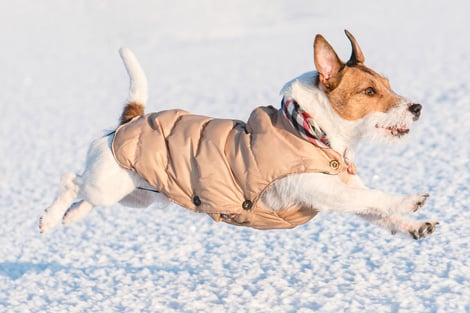Choosing Safe and Comfortable Pet Clothing

Pet clothing. Sounds like the punchline of a joke.
In fact, it was, in an episode of the comedy series Portlandia. Roseanne Barr guest stars as the “temporary mayor” of the city. As she strolls around admiring charming shops selling clothing, eyeglasses, and bakery items, her guides keep reminding her: “Those are for dogs.” That comedic moment was rooted in reality. According to Fortune Business Insights, the global pet clothing market topped $5 billion in 2020, an increase of 8.11% from the previous year — and that was during an economic downturn.
It demonstrates that some pet parents are willing to spend big bucks to dress up their pets in adorable outfits. And we have to admit, they can be pretty cute!
But is pet clothing necessary? Sometimes it is helpful, especially for hairless or short-haired breeds living in cold regions.
There are some things you need to know before you dress up your kitty like Cleopatra. Or your pug like a spider.
Things to Consider Before Purchasing Pet Clothing
The organization PDSA provides some excellent guidelines in an article titled “Is it OK to dress up my pet?” Their top question is: Is it helping your pet or is it simply for your enjoyment?
Ask yourself the following questions when choosing clothing for your pet:
- Can my pet do normal pet things? Your pet needs to be able to breathe, bark or meow, lie down, sit, walk, run, jump, roll, go potty, and groom themselves without choking, chafing, or cutting off their blood circulation to their ears, legs, or tail. Also, clothing can prevent your pet’s natural ability to control their body temperature.
- Does clothing cause my pet stress? While it might look adorable to you, look for signs of stress in your pet, especially cats. Watch for cats grooming themselves more than usual. Stressed dogs might lick their lips, yawn, or pant more than usual. If they try to wriggle out of the clothing, it can lead to chafing, choking, or cut off their blood supply, so be sure that your pet tolerates the clothing and that it fits well before leaving it on for more than a minute.
- Can my pet tell me or other pets what they feel? Body language (tails, fur standing up, mouths) is the primary way that dogs “talk” with each other as social cues. If your dog is dressed up, other dogs might not be able to read their signals. And if your dog is stressed, they might act differently toward other animals. It can also prevent you from reading their signals too.
- Is it kind? Our pets are in our care, and they need to be respected as the animals that they are. If you are dressing them up for your enjoyment, be ready for a quick photo and then take it off if your pet just doesn’t like the experience. You can still get a giggle and know that you’ve captured something cute but not harmful to your pet. Don’t force a pet to wear clothing since that might lead to behavior problems. It can make it tough for them to tolerate those kinds of clothing or safety items that may be necessary for your pet’s health and safety at the vet’s office or after a surgery or during the time needed to heal wounds.
When Pet Clothing Makes Sense
A good way to determine whether to get pet clothing is if it keeps your pet warm, comfortable, or safe.
Here are some types of clothes that are actually useful:
- Winter coats. Here in the Midwest, we have some cold winters, and some breeds of dogs with missing or thin fur benefit from wearing a winter coat. Ask your veterinarian if they believe a coat would be good for them to wear inside or outside only when it’s cold outside.
- Booties. Booties can protect dogs from getting cuts, scrapes, salt, or snow buildup at the bottom of their paws. However, it’s not always easy to get them to stay on, so get your dogs used to wearing them a little bit more every day. Do be cautious that they’re not too tight; they can cut the circulation off to your pets' feet.
- Surgical vests and therapy tops. Sometimes after surgery or due to illness or trauma, vets will give you a surgical vest to protect their stitches or allow wounds to heal. Like all pet clothing, these vests need to fit properly so your pet can do normal pet things.
- High-visibility jackets. Brightly colored and reflective clothing can help pets be more visible to keep them safe in traffic or any other place where they need to be seen.
A couple more things to keep in mind. Pets should be supervised when they are wearing clothing so you can watch for the signs of stress or if it’s causing harm, as mentioned above. Dog jackets should have openings for harnesses or leashes. And some fabrics can be irritating to their skin or flammable.
But... Halloween!
Okay, I know some of you are still going to want to dress up your dog for Halloween or other fun holidays or events.
Some pets do enjoy being a part of this family activity, so if you are going that route, check out these suggestions for fun and safe Halloween costumes for dogs from Preventative Vet. The article reminds us to be aware of your pet’s personality and to pick (or make) a costume that suits them. If they hate the feeling of having things put over their head, don’t do it to them.
I love this suggestion for a beanie baby costume (just a tag) for fluffy pups or dogs that aren’t down for dressing up (though I would check that the dog’s front leg can’t get caught up in the tag).
The Preventative Vet article suggests taking these three steps before dressing up your dog.
- Know your dog’s personality type.
- Make sure the costume fits properly. They need to be able to breathe and move properly.
- Make sure the costume is safe. Watch out for objects or attachments (strings, bells, small items) that they will be able to chew off, or parts that can choke, chafe, or cut off their blood supply.
Clothing for Cats? Probably Not
Cats rarely like to wear clothing. In an article at PetCoach.com, Dr. Nancy Dunkle, founder of a cat veterinary hospital, says, “I’ve never seen a cat wearing a costume or clothing that looked happy per his facial and body language.”
If you are determined to dress up your cat for a holiday, the safest route is a seasonal-themed breakaway collar.
Naked or Dressed—Pets Are Adorable
When in doubt, I’d suggest letting your pet be as nature intended. But you can also ask your veterinarian about the safety and utility of pet clothing. Pet store employees might know what’s safe or useful, but their job is to sell products, so buyers beware.
Above all, you can “ask” your pet what they think about it. In my experience, they will let you know just by looking at them and seeing how they react to it. I’m just happy that my cat Pearl always wears her breakaway collar, and from time to time I check to see if I can put a finger comfortably between her and her collar for her safety and my peace of mind.

